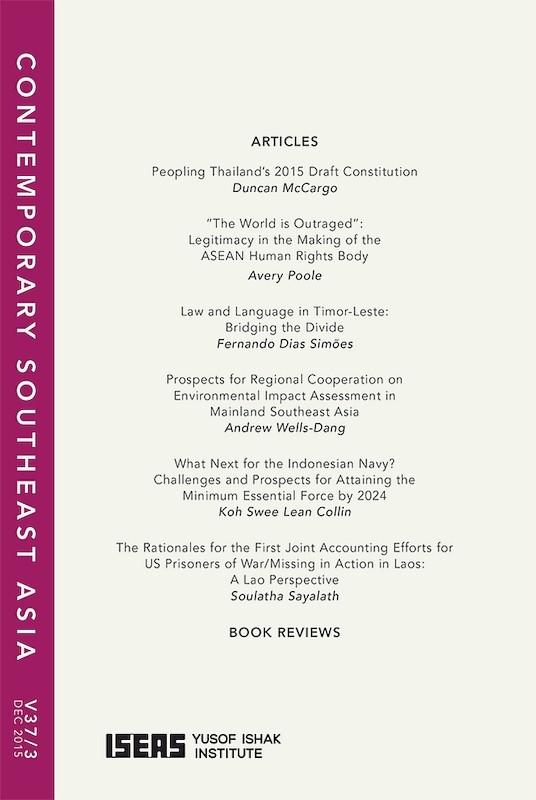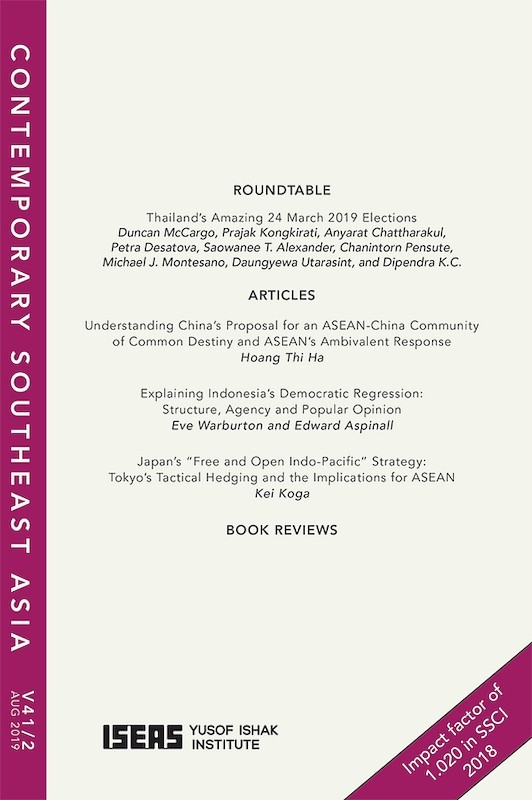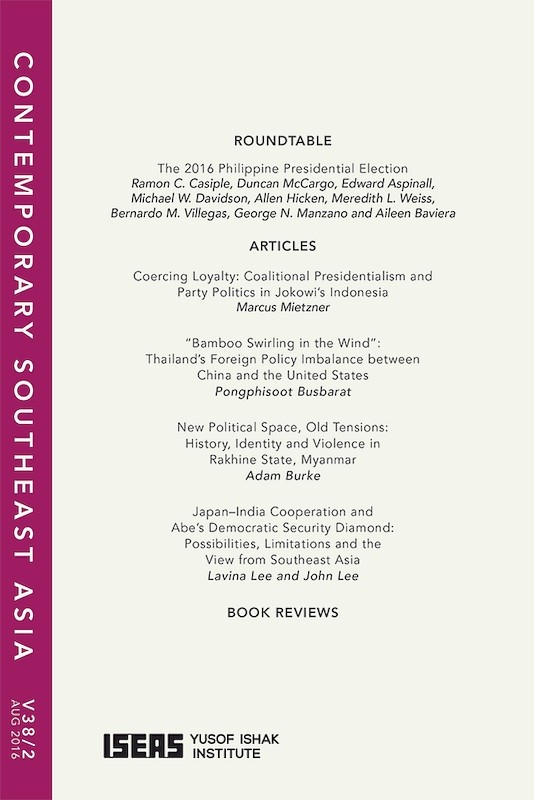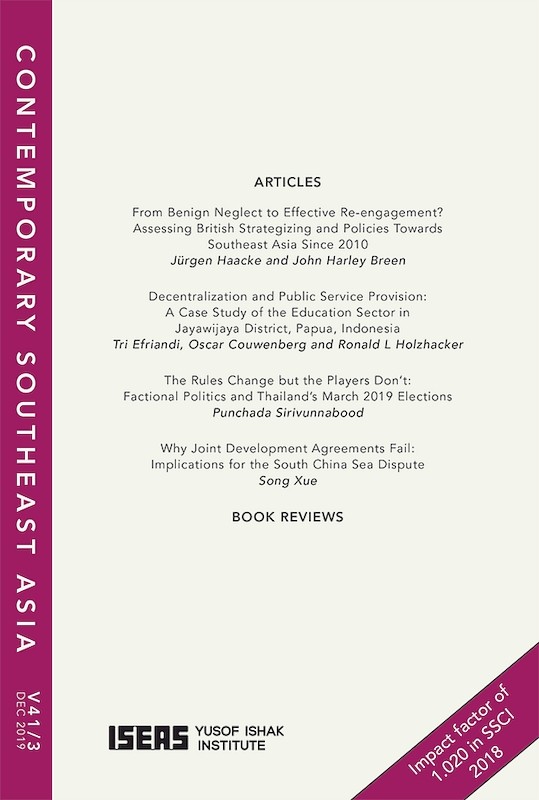Contemporary Southeast Asia Vol. 40/1 (April 2018)

Ian Storey, editor
Date of publication:
April 2018
Publisher:
ISEAS – Yusof Ishak Institute
Number of pages:
172
Code:
CS40/1
About the publication
- Attained impact factor of 0.906 in Social Sciences Citation Index 2017
- Ranked 18th by Google Scholar Metrics 2018 in the Asian Studies and History category
Contents
-
Contemporary Southeast Asia Vol. 40/1 (April 2018)
[Whole Publication, ISSN: 1793284X] -
Preliminary pages
- ARTICLES
-
1. All Going According to Plan? The Armed Forces and Government in Myanmar, by Andrew Selth, author see abstractIt has become the conventional wisdom that the transition from authoritarian rule to a more democratic form of government in Myanmar was due to the efforts of Aung San Suu Kyi and the National League for Democracy, the pressures applied against the military regime by Western democracies and belated recognition by the ruling generals that Myanmar could not continue down the path of political and economic isolation. This narrative suits many of the key actors in this drama, but it denies independent agency to the most important player of all, namely the country’s armed forces. The paradigm shift which has occurred in the country’s political landscape over the past decade can more accurately be described as the result of a long-term plan drawn up by Myanmar’s military leadership, which surrendered absolute power in a calculated move to advance its own agenda through the controlled transition to a “disciplined democracy”.
-
2. “Us” Versus “Them”: An Ideological Battle for Electorates on Political YouTube Videos in the 2016 Sarawak State Election, by Hah Foong Lian, author see abstractThis article explores the use of online videos posted on the YouTube platform by major political parties contesting state elections in Sarawak, Malaysia in 2016. Guided by cultural theorist Stuart Hall’s notion of representation, this article argues that prevailing ideological beliefs can be articulated and amplified through cultural texts, symbols and signifiers that represent Sarawakian identity. The contents of 35 online videos posted between January and May 2016 were qualitatively analysed to understand the use of online videos to promote Sarawak nationalism during the election. The 35 videos consisted of eight music, 12 satirical and 15 promotional videos which were produced and posted by Barisan Nasional (BN) and the opposition parties. This article finds that BN had constructed in its videos the notion of “local heroes” and “foreign villains” which could be interpreted as an ideological reinforcement of state nationalism in the battle for voter support at the ballot boxes. The opposition-created videos, however, framed BN in a negative light. More importantly, both contending parties employed state nationalism as an ideology to garner electoral support by depicting Putrajaya, the federal administrative capital of Malaysia, as the “foreign other” to be defeated at the polls as the federal capital is regarded as attempting to impose its policies on the state of Sarawak.
-
3. US Domestic Politics and America’s Withdrawal from the Trans-Pacific Partnership: Implications for Southeast Asia, by Shaun Narine, author see abstractThe Trump administration’s decision to withdraw from the Trans-Pacific Partnership (TPP) agreement has damaged America’s political standing in the Asia Pacific and reinforced concerns that Washington is not committed to the maintenance of regional stability. This article examines the reasons for the Trump administration’s decision and evaluates the likelihood of America entering a new multilateral free trade agreement (FTA) with the Asia Pacific. For the foreseeable future this is unlikely. Understanding why requires a careful examination of the forces shaping US domestic politics. In America, FTAs have become powerful symbols of US economic inequality to both the political left and right. However, the real causes of economic inequality are structural economic changes and America’s unwillingness to implement the social welfare programmes needed to alleviate their effects. The US resistance to government-provided social welfare is rooted in the ideological, racial and socio-economic structures of American society. Thus, effectively addressing economic inequality will be difficult and the subject of considerable strife within American domestic politics. This article argues that so long as FTAs serve as convenient political scapegoats for deep-seated characteristics of the American state, the United States will not enter into such economic agreements. The article goes on to examine how Southeast Asia may be affected by the particular set of political forces in America that led to its withdrawal from the TPP. The Trump administration is hostile to multilateral institutions, which harms cooperative regional relations and accelerates America’s decline in the Asia Pacific.
-
4. Timor-Leste’s Challenged Political Process: 2016–17, by Damien Kingsbury, author see abstractAs 2017 unfolded, Timor-Leste appeared to be consolidating its democratic embrace, with peaceful, locally organized democratic elections. Medium- to longer-term prospects for the recently independent country, however, were more ambiguous, with the country’s reliance on oil receipts being tested against still low levels of development. This article proposes that, despite a decade of stability, material improvement has been limited for many of Timor-Leste’s people and exacerbated by growing perceptions of corruption among the country’s elite. Timor-Leste’s social and political stability, therefore, by conventional criteria, appeared vulnerable and its democracy potentially fragile. All of this was exacerbated by the formation of a minority government which failed to achieve the type of inclusion that would have secured a higher degree of political certainty and stability. Instead, the majority opposition formed a political bloc to challenge the government’s programme, including its budget, voting it down twice and hence establishing grounds for the formation of a new government or fresh elections. Set against increasingly confrontational rhetoric, the country’s political stability was, by the end of 2017, in tatters, with a return to the type of bitter divisions that marked the political environment just over a decade ago.
-
5. Maritime Territorialization, UNCLOS and the Timor Sea Dispute, by Rebecca Strating, author see abstractIn recent years, maritime sovereignty disputes have become highly visible microcosms of broader contests in the Asia-Pacific region. While material factors have provided potential flashpoints for conflict in the maritime domain, these conflicts are also motivated by ideational factors as sovereignty claims link national identity, status and prestige to the defence of maritime possessions. This article examines the way that maritime spaces have become increasingly linked to, and conflated with, state sovereignty in public discourses, a process articulated as “maritime territorialization”. As a case study, this article uses the Timor Sea dispute between the small Southeast Asian state of Timor-Leste and its much larger neighbour Australia over maritime boundaries, territory and oil and gas reserves. It examines the specific maritime territorialization discourses employed by Timor-Leste’s leaders and supporters, and considers some of the broader implications for maritime disputes in the Asia-Pacific region.
-
6. Regionalizing Health Security: Thailand’s Leadership Ambitions in Mainland Southeast Asian Disease Control, by Clare Wenham, author see abstractSince the emergence of HIV/AIDS and SARS, Thailand has understood the security threat posed by disease and has responded by investing in the country’s disease control infrastructure, such as through the development of the Field Epidemiology Training Program (FETP), improving pandemic preparedness, and collaborating with other states, international organizations, non-governmental organizations and private initiatives to ensure health security. This has led to the creation of a multi-stakeholder subregional governance network for disease control. However, underpinning this network is the individual transformation of Thailand, which, beyond acting as a norm entrepreneur, has scaled up its activities in disease control to become a would-be leader in disease control in mainland Southeast Asia. By using Lake’s conceptions of hierarchy and Nolte’s understanding of regional power, this article shows how Thailand has taken on this leadership role and has been able to dominate the normative processes of subregional disease control and in doing so has strengthened its own economic and national security. Moreover, this article draws conclusions for regional governance more broadly, through examining power dynamics between states within the arrangement.
- BOOK REVIEWS
-
BOOK REVIEW: Khaki Capital: The Political Economy of the Military in Southeast Asia, edited by Paul Chambers and Napisa Waitoolkiat , by John Blaxland, author
-
BOOK REVIEW: Liberalism Disavowed: Communitarianism and State Capitalism in Singapore. by Chua Beng Huat, by Stephan Ortmann, author
-
BOOK REVIEW: Energy, Governance and Security in Thailand and Myanmar (Burma), by Adam Simpson, by Nigel Gould-Navies, author
-
BOOK REVIEW: Southeast Asia and China: A Contest in Mutual Socialization, edited by Lowell Dittmer and Ngeow Chow Bing, by Cheunboran Chanborey, author
-
BOOK REVIEW: Thailand: Shifting Ground between the US and a Rising China, by Benjamin Zawacki, by Pongphisoot Busbarat, author
-
BOOK REVIEW: East of India, South of China: Sino-Indian Encounters in Southeast Asia, by Amitav Acharya, by Rahul Mishra, author






